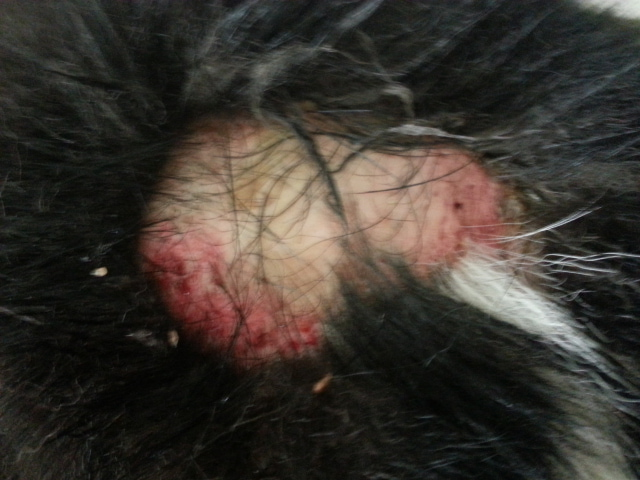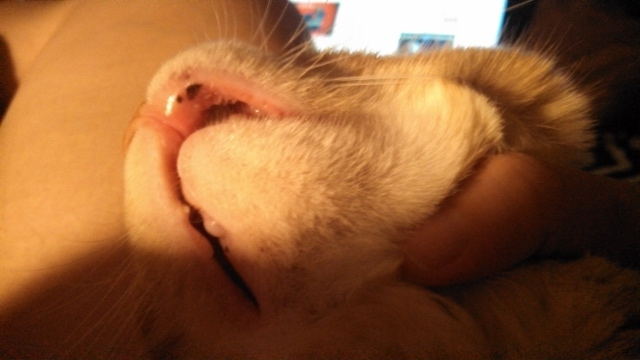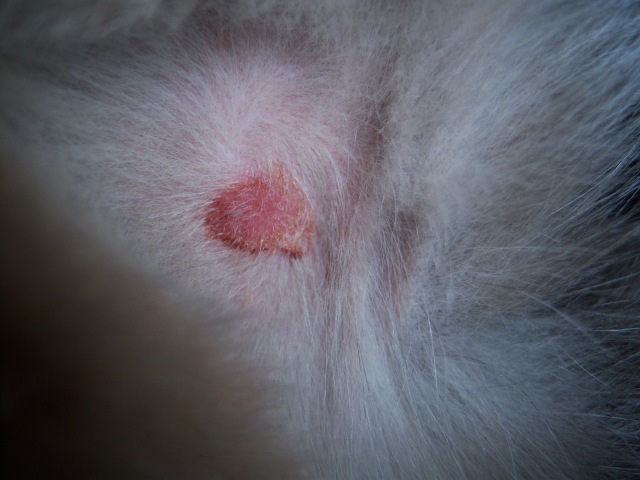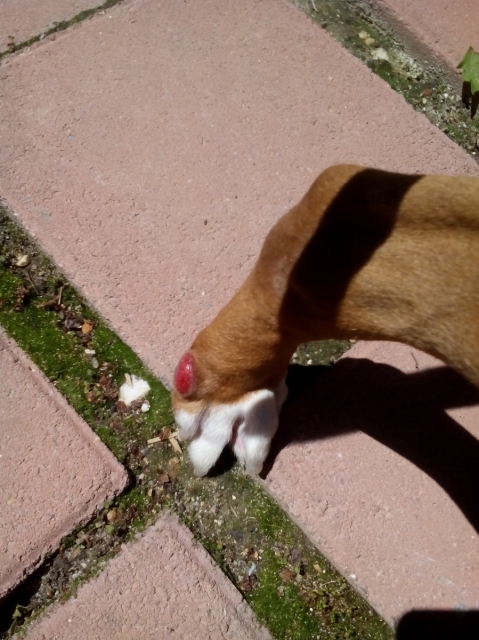QuestionPatient is a 10 year old Chesapeake, spayed female, approx 95 lbs. She had a 100% right ear oblation when less than 1 yr. old. The ear flap is in place, and she has had 1 or 2 instances of what we thought was an internal infection in this area over her lifetime. Approximately 1 year ago she nearly died from dehydration ralated to some type of inflamation in and around her head. She was in too much pain to drink or eat or rest. Initial treatment was with antibiotics, which seemed to aggravate the symptoms. Antibiotics were stopped and morphine was administered, and a cycle of steroids (prednisone)was initiated. This snapped her out of her condition over a two day period, but caused her to become some what nutty. She was drinking gallons of water and hungry all of the time. Over time we weaned her down to a very low dosage of the steroid, eventually eliminating it. For the remainder of the following year I gave her a half of prednisone tablet when ever I would detect her having irritation in/around her head. This has seemed to keep her problems in check and to give every one quality of life.
About two weeks ago, overnight, she began to drink excessively and have to urinate constantly. It hasn't stopped. She drinks a full bowl of water and then patrols the house looking to get into and drain the toilet bowls, then runs for the door. This went on constantly for days and nights, she will have to get out every 20 minutes, then every 40 minutes, it is now down to every two hours during the day and every 2-3 hours during the night. Our vet prescribed antibiotics, two pills, twice a day. We mistakenly administered one pill, twice a day for the first two days and saw no improvement. We then began the proper dosage and started to see minor improvement, to the point where she can now get through about 2-4 hours on her consume and evacuate cycle with the water. What do you think?
AnswerThis excessive thirst is not typical of a UTI. I would recommend a simple chemistry screen to check kidney and liver function and rule out Diabetes, but it sounds as if she may have Cushing's Disease (info below).
Canine hyperadrenocorticism
Cushing's disease, Cushing's syndrome
AffectedAnimals:
Although dogs of almost every age have been reported to have Cushing's disease, it is most common in middle-aged and older dogs. Most dogs diagnosed with Cushing's disease are at least nine to 10 years old. Slightly more female dogs are affected than male dogs. Large breed dogs tend to be affected more often than smaller breeds. Several breeds are more commonly diagnosed with PDH than others, including poodles, terriers, German shepherds, dachshunds, beagles, and boxers. Many of these same breeds are also reported to have adrenal gland tumors at a greater frequency.
Overview:
Cushing’s disease results from excessive production of cortisol, a hormone normally produced by the adrenal glands. This excessive cortisol production can result from abnormalities in the pituitary gland that cause excessive hormone secretion by the adrenal glands, by tumors within the adrenal glands themselves, or by a combination of these factors.
A variety of symptoms can result from excess cortisol, the most common of which include increased thirst and urination, increased appetite, panting, and skin changes such as hair loss and thinning of the skin. Efforts to distinguish which form of the disease is present are important, as this can influence treatment recommendations. Blood tests and imaging procedures, including abdominal ultrasound, may be needed to make this distinction. Pituitary-dependent Cushing’s disease is usually treated with medication. Adrenal gland tumors are best addressed surgically, although they can also be treated medically in situations in which surgery is not advised.
Complications due to Cushing’s disease and its treatment are common, but with careful diagnosis and management, many dogs with Cushing’s disease can survive for as long as two to three years or more, depending on a number of factors.
Clinical Signs:
Polydipsia, polyuria, polyphagia, panting, alopecia, hyperpigmentation, calcinosis cutis, abdominal distention, muscle weakness, lethargy, pyoderma, seborrhea, bruising, obesity, testicular atrophy, failure to cycle, myotonia, facial paralysis, bruising.
Symptoms:
Increased thirst, increased urination, increased appetite, panting, hair loss, darkening of the skin, thinning of the skin, abdominal enlargement, skin infections, flaky or greasy skin changes, weakness, tiredness, obesity, reproductive changes, bruising.
Description:
Cushing's syndrome refers to the signs and changes that occur secondary to excessive cortisol production by the adrenal glands. Cortisol is a hormone that is necessary for many normal body functions. Its secretion from the adrenal glands is regulated by input from two regions in the brain, the hypothalamus and the pituitary gland. The hypothalamus, a small structure in the brain, secretes corticotropin-releasing hormone, or CRH, which in turn acts on the pituitary gland, also located in the brain. The pituitary gland releases adrenocorticotropic hormone, or ACTH, which then stimulates the adrenal gland to make cortisol. The cortisol produced by the adrenal gland feeds back to both the hypothalamus and the pituitary gland to regulate production of CRH and ACTH.
Although the exact mechanism that causes Cushing's disease to develop is not completely understood, there are many possible causes. In general, there are two forms—PDH and adrenal gland tumors. The most common is the pituitary-dependent Cushing's disease. Some dogs with pituitary-dependent disease have microscopic tumors that cause the excessive ACTH production, leading to excessive cortisol secretion from the adrenal glands, while others have larger tumors that cause the same result. Some dogs with PDH do not have discrete tumors in their pituitary glands, but the cells there still produce excessive ACTH.
Dogs with the less common form of the disease, adrenal gland tumors, may have either benign or malignant tumors that produce excessive amounts of cortisol from one or both adrenal glands. The excessive cortisol concentrations in the dog's blood then lead to the clinical signs, and the changes in the bloodwork and other diagnostic findings discovered by the veterinarian. Although most dogs with Cushing's disease are not in critical condition at the time of diagnosis, serious complications of Cushing's disease are possible. These include high blood pressure; urinary tract infection and stone formation; changes in the portion of the kidney where blood is filtered; congestive heart failure; pancreatitis; diabetes; and blood clot formation, especially in the vessels supplying the lungs.
There are both surgical and medical treatments for Cushing's disease. Surgery is the preferred way to manage dogs with adrenal tumors, while medical treatment is used for dogs with PDH. The goals with treatment are to eliminate or minimize signs due to excessive cortisol production, and to prevent potentially life-threatening complications from the disease. Dogs treated successfully for Cushing's disease live for an average of two to three years.
Diagnosis:
A definitive diagnosis of Cushing's disease can be difficult to obtain. When animals present with the classic signs of the disease, the diagnosis is initially suspected on the basis of those signs and the results of routine laboratory tests. As with many illnesses, a complete blood count, biochemistry profile, and urinalysis are very important tools in the initial evaluation of a dog suspected of having Cushing's disease. Usually there will be changes on these tests that may indicate the possibility of Cushing's disease. Routine imaging procedures, such as abdominal x-rays, may show changes including generalized liver enlargement, and, less commonly, adrenal gland enlargement or mineralization. Abdominal ultrasound is also used frequently in the evaluation of Cushing's suspects to evaluate the liver size and texture, the size and shape of the adrenal glands, and to look for evidence of other abnormalities that might be contributing to the dog's signs.
A more definitive diagnosis depends on the results of tests that look more specifically at adrenal gland function. The urine cortisol-to-creatinine ratio is used in some cases, but it is not a very specific test because dogs with almost any illness can have an abnormal result. The two most commonly used screening tests are the ACTH stimulation test, and the low-dose dexamethasone suppression test. Yet, it can be very difficult to know for sure that an individual dog has Cushing's disease, since the results of the tests can be difficult to interpret.
Once a tentative diagnosis of Cushing's disease is established, an attempt to distinguish which form of the disease is present should be made. Pituitary dependent hyperadrenocorticism, or PDH, is the more common form, accounting for as many as 80 to 85 percent of patients with Cushing's disease. The remaining dogs have adrenal gland tumors, which can affect either one or both adrenal glands. In very rare circumstances, both PDH and an adrenal tumor can be present in the same dog. The tests most commonly used to distinguish the pituitary-dependent form from an adrenal tumor are the high-dose dexamethasone suppression test, the endogenous ACTH level, and abdominal ultrasound. CAT scans can also be used to evaluate adrenal gland structure, and MRI scans can be used to look for pathology in the pituitary gland.
Prognosis:
The outlook for surgical treatment of adrenal gland tumors is fairly good, provided that the animal survives the surgery and the period immediately after it. As a rule, dogs with benign adrenal gland tumors live longer than dogs with malignant tumors. Metastasis, or spread of a malignant tumor, makes for a worse prognosis. Such animals can be treated successfully with medication to help keep symptoms under control after surgery. Dogs that survive surgery are reported to have an average survival time of as long as 36 months.
Dogs treated successfully for PDH live approximately two years. Some dogs do not do that well, while others may live for 10 years or more depending on their age at the time of diagnosis, the presence of additional disorders, and the development of complications related to the treatment. Relapses are common in patients treated medically, with many dogs requiring medication adjustments due to recurrence of signs in the first year. Almost half of all dogs with Cushing's disease that die do so because of problems related either to the disease itself or its treatment. However, despite a guarded long-term prognosis, the majority of dogs can lead lives of an excellent quality with careful monitoring and attention to detail.
Transmission or Cause:
The exact events that lead to the development of Cushing's disease are not known at this time. The majority of dogs with the illness have a pituitary gland problem, while the remaining dogs have adrenal gland tumors. Rarely, a single dog can have both pituitary-dependent Cushing’s disease and an adrenal gland tumor.
Treatment:
Treatment of Cushing's disease depends on which form of the disease is present. With PDH, the main treatments are medications. Although surgery to remove the pituitary gland or the adrenal glands has been performed, the results with medical treatment are better, and the risk of these surgeries, at least at this time, makes them difficult to recommend.
The drug used most commonly to treat pituitary-dependent Cushing's disease is o,p'-DDD, also known as Lysodren or mitotane. Lysodren is used at first on a daily basis. This drug works by actually causing death of the cortisol-producing cells in the adrenal gland. Dogs without Cushing's disease appear more resistant to the drug's effects than dogs with the illness. Very careful monitoring is necessary once Lysodren has been prescribed. Key factors to observe include thirst, appetite, and general overall disposition. Prior to beginning treatment, the veterinarian may ask that close attention be paid to the dog’s appetite and how much food the dog eats. The amount of water a dog drinks over several days should be measured prior to treatment. This helps owners recognize one of the key endpoints of induction treatment: when water consumption drops below 50 milliliters per pound of body weight per day. In some cases, if decreases in appetite, water consumption, or the development of lethargy are not observed, the ACTH stimulation test will be checked after seven days of treatment to see if the endpoint of induction has been reached.
Based on the dog’s symptoms and ACTH stimulation test results, a lower dose of the drug is administered during the maintenance phase. Once induction is complete, dogs are given doses of Lysodren, usually two to three times a week, to keep the disease in check. Often, the veterinarian will need to make adjustments in the medication dose according to the recurrence of symptoms during maintenance treatment. Sometimes dogs are given prednisone in addition to Lysodren to avoid adverse consequences of Lysodren treatment, but with very careful monitoring, this additional treatment may not be necessary. Complications during treatment with Lysodren can include the development of signs due to decreased cortisol production from the adrenal glands. These signs, which can be severe and life-threatening if they go unrecognized, include weakness, lethargy worse than the lethargy existing present prior to treatment, loss of appetite, vomiting, diarrhea, and in severe cases, collapse or even shock. Neurological symptoms can occur either as a side effect of Lysodren, or from growth of the pituitary tumor that caused the Cushing's disease in the first place. ACTH stimulation tests are repeated every three to four months to ensure adequate control of the disease.
Dogs treated successfully with Lysodren usually return fairly quickly to normal amounts of water intake, urination, and food intake—often within seven to 14 days. Strength may improve within a few days to a few weeks, and the appearance of a pot belly may diminish. Skin changes and panting usually take much longer to resolve, as do reproductive disorders. Liver enzyme abnormalities and elevated systemic blood pressure readings may take as long as three to 12 months or more to resolve.
Another drug used for medical treatment of PDH is Anipryl, or L-deprenyl. This drug is also used to treat older pets with a behavioral disorder called cognitive dysfunction syndrome. The drug works by influencing dopamine concentrations in the central nervous system, which in turn then influence production of ACTH by the pituitary gland. There is controversy as to the effectiveness of this drug. However, since the potential side effects are less severe than those that can occur with Lysodren, it is used in some dogs, particularly geriatric dogs with multiple health problems.
Ketoconazole is another drug used for medical treatment of PDH. It acts by blocking the formation of cortisol in the adrenal glands. It can also be given to dogs with adrenal gland tumors that will not be receiving surgery, or to help control symptoms prior to surgery. Some dogs that cannot tolerate Lysodren can be treated successfully with ketoconazole. Its main side effect is the potential to cause injury to the liver.
In dogs with PDH that have large pituitary gland tumors—particularly those dogs with neurological signs due to the physical presence of a large pituitary mass—the primary treatment is radiation therapy to control the growth of the tumor.
Dogs with adrenal tumors can be treated surgically or medically. The main treatment for adrenal tumors is surgical removal. The surgery is technically a very difficult one, with many potential complications during and after the procedure. A surgeon experienced in removing adrenal gland tumors should perform it. After surgery, animals often need to be supplemented with both glucocorticoids and mineralocorticoids, the two primary types of steroids normally produced by the adrenal gland. Sometimes supplementation can be tapered as the remaining adrenal gland begins to function again, but some dogs will require supplementation for life.
Drugs used for the medical treatment of adrenal tumors include Lysodren and ketoconazole. Dogs with large and likely inoperable tumors on x-rays or ultrasound, dogs that are very sick, old, or debilitated, and dogs with suspected spread of a malignant adrenal gland tumor are all candidates for medical treatment, as are pets whose owners cannot afford the surgery.
Prevention:
The exact cause of Cushing's disease is not known, and there is no way of preventing the disease from developing. Since similar signs can occur in dogs that are treated for long periods of time with high doses of cortisone, this treatment should be avoided wherever possible. In these dogs with so-called "iatrogenic Cushing's disease," the signs should resolve as the cortisone dose is tapered.

 German shepherd skin issue please help
Question
back side back and tail
It start
German shepherd skin issue please help
Question
back side back and tail
It start
 sore on lip
Question
lilly lip
Hello, Im writing to ask abou
sore on lip
Question
lilly lip
Hello, Im writing to ask abou
 Mini Pin.. not activity
Question
Mini Pin 1 1/2 year ol
I have a 1 1/2 year old
Mini Pin.. not activity
Question
Mini Pin 1 1/2 year ol
I have a 1 1/2 year old
 Skin (allergy) issues
Question
Licking sore
Tao my cat is about 9 years old,
Skin (allergy) issues
Question
Licking sore
Tao my cat is about 9 years old,
 Large boil like bump
Question
back paw
My 2 year old bull mastiff has
Large boil like bump
Question
back paw
My 2 year old bull mastiff has